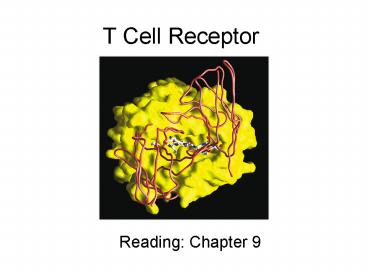T Cell Receptor PowerPoint PPT Presentation
1 / 26
Title: T Cell Receptor
1
T Cell Receptor
- Reading Chapter 9
2
Key Concepts
- TCR
- Membrane bound, no soluble form
- Heterodimer of ? and ? chains or ? and ? chains
- Expression levels of TCR on T cells
- Expression and function requires CD3 (signal
transducing complex)
3
- T cells activation is specific for antigen plus
MHC and not antigen alone - T cells recognize antigen only when it is
presented by a self-MHC molecule - Self-restriction is specific to T cells (not
exhibited in B cells) - How? Dual-receptor model vs. Altered-self model
4
- Isolation and identification of the TCR
- Generation of clonotypic antibodies isolated ??
and ?? heterodimers - Hedrick and Davis use subtractive hybridization
to isolate TCR genes - Identified clone
- Specifically expressed in T cell clones
- Gene sequence that rearranges
- Expressed as a membrane bound protein
5
- TCR Structure
- Resembles the Fab fragment of Ig
- Two domains with an intrachain disulfide bond
- NH2 domain contains sequence variation (3 CDRs in
V? and V?) - C region with the short connecting sequence
- Forms a disulfide bond between the two chains
- Transmembrane region
- Site of interaction with CD3
- Cytoplasmic tail
- 5-12 aa at COOH end
6
- Specific characteristics of TCRs
- Expression levels
- Function
- ?? TCR interacts with peptide-class II MHC on APC
cells and target cells - Activated cells proliferate T cells with high
affinity receptors are selected for the
cell-mediated immune response - ?? TCR recognizes antigen that is not presented
by MHC - Ex. phospholipid antigens on bacteria and
parasites - Direct recognition of antigen innate immunity
- Secrete cytokines recruitment of ?? T cells
7
- ?? TCR and ?? TCR have distinct shape
- ?? TCR and ?? TCR exhibit different elbow angles
between the long axis of the variable and
constant regions - Influences the interaction with co-receptors
results in intracellular signaling differences - ?? TCR forms a deep cleft on the surface of the
molecule where phospholipid can bind directly (no
MHC presentation is required)
8
- Organization and rearrangement of TCR Genes
- ?? and ?? TCR are expressed only in T lymphocytes
- Functional TCR genes are produced by
rearrangement similar to Ig genes - V and J segments undergo rearrangement in ? and ?
chains - V,D,J, segments undergo rearrangement in the ?
and ? chains
9
(No Transcript)
10
- Rearrangement of TCR variable regions
- ? chain (homologous to L chain of Ig) is encoded
by V,J, C gene segments, rearrangement involves
VJ joining - ? chain (homologous to H chain of Ig) is encoded
by V,D,J and C segments, rearrangement involves
VDJ joining (see notes)
11
Mechanism for TCR DNA Rearrangement
- Conserved RSS with 12 bp (1 turn) or 23 bp (2
turn) spacer sequences - All rearrangements follow the 12/23 joining rule
- Pre T cells express recombination-activating
genes RAG1 and RAG2 - RAG1/2 recombinase enzymes recognize RSS
sequences and promote V-J and V-D-J joining - Consequence each cellular rearrangement event
generates a unique DNA sequence for TCR
expression in that cell
12
- Rearranged TCR genes
- Functional rearrangement generates 3 CDRs in
variable region - CDR1 and CDR2 are generated by combinatorial
joining - CDR3 is generated by junctional diversity and N
region nucleotide addition
13
(No Transcript)
14
See supplemental notes
15
See supplemental notes
16
- TCR complex is TCR-CD3 membrane complex
- CD3 function
- CD3 associates with ?? and ?? TCR
- Complex of 5 invariant polypeptide chains that
associate and form 3 dimers - Most common dimer is ?? homodomer, importance of
CD3 dimers and ITAM
17
- T cell Accessory membrane molecules
- Function strengthen the interaction between T
cells and APCs or target cells - CD4 and CD8 are important co-receptors for the
recognition of peptide-MHC
18
- Structural features of CD4 and CD8
- CD4 55 kDa,monomeric membrane glycoprotein with
4 extracellular Ig like domains, hydrophobic
transmembrane region, long cytoplasmic tail with
phosphorylatable serines - CD8 disulfide linked ?? heterodimer or ??
homodimer - Small glycoprotein, 30-38 kDa, 1 extracellular Ig
region, hyrdrophobic transmembrane region,
cytosplasmic tail with 25-27 aa (many can be
phosphorylated)
19
- Contact of class I MHC with HLA-A2-peptide
- CD8 binds by contacting ?2, ?3, ?2 microglobulin
domains in MHC I
20
- Membrane distal domain of CD4 interacts with the
hydophobic pocket formed by ?2 and ?2 domains of
MHC II
21
- Affinity of TCR for Peptide-MHC complexes
- TCR binding affinity
- Importance of cell adhesion molecules and
strengthening the trimolecular complex - Sequence of events regulating the activation of T
cells
22
(No Transcript)
23
- 3D structure of a TCR-peptide -MHC complex
- Interaction between human TCR, HLA-A2 class I
MHC-peptide complex
24
- Hypervariable loops (CDRs) of human ? and ?
chains of TCR and ?1, ?2 chains of HLA-A2 - Recognition of peptide-MHC occurs as variable
regions CDR1 and CDR3 contact peptide and large
area of MHC - Peptide is buried deep within class I MHC
- TCR fits across the peptide and interacts with
high points of MHC
25
- Class I and Class II MHC-peptide complexes
interact with T cells differently - Different angle at which TCR sits on the MHC
complex - Greater number of contact aas between TCR and
class II MHC than that seen in TCR and class I
MHC interaction
26
(No Transcript)

